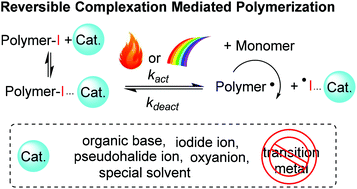Reversible complexation mediated polymerization: an emerging type of organocatalytically controlled radical polymerization
Abstract
As a newly developed approach of controlled radical polymerization (CRP), reversible complexation mediated polymerization (RCMP) was established in 2011 by Goto et al., using iodine as a capping agent and organic molecules as catalysts (such as organic amines and organic salts), which can be regarded as an organocatalytic counterpart of ATRP. Nowadays, RCMP is attracting extensive attention, due to the constantly emerging outstanding achievements and its appealing intrinsic features including the use of inexpensive and relatively nontoxic compounds, convenient operation, various types of monomers and applicability to a range of polymer designs. Remarkably, photo-RCMP is among the most simple, inexpensive, and robust photoinduced CRPs. Their feasibility over the whole visible region and even the near-infrared region is unprecedented. In this review, we summarize in detail the research on RCMP in the last ten years since its birth, mainly focusing on the development and evolution of catalytic systems, photo-induced RCMP and the special applications derived from their inherent characteristics.

- This article is part of the themed collections: Polymer Chemistry Recent HOT Articles and Polymer Chemistry Most Popular 2022


 Please wait while we load your content...
Please wait while we load your content...